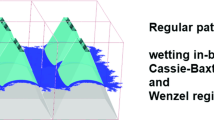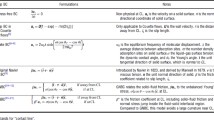Abstract.
For one-component volatile fluids governed by dispersion forces an effective interface Hamiltonian, derived from a microscopic density functional theory, is used to study complete wetting of geometrically structured substrates. Also the long range of substrate potentials is explicitly taken into account. Four types of geometrical patterns are considered: i) one-dimensional periodic arrays of rectangular or parabolic grooves and ii) two-dimensional lattices of cylindrical or parabolic pits. We present numerical evidence that at the centers of the cavity regions the thicknesses of the adsorbed films obey precisely the same geometrical covariance relation, which has been recently reported for complete cone and wedge filling. However, this covariance does not hold for the laterally averaged wetting film thicknesses. For sufficiently deep cavities with vertical walls and close to liquid-gas phase coexistence in the bulk, the film thicknesses exhibit an effective planar scaling regime, which as a function of undersaturation is characterized by a power law with the common critical exponent -1/3 as for a flat substrate, but with the amplitude depending on the geometrical features.
Similar content being viewed by others
References
O. Gang, K.J. Alvine, M. Fukuto, P.S. Pershan, C.T. Black, B.M. Ocko, Phys. Rev. Lett. 95, 217801 (2005).
L. Bruschi, A. Carlin, G. Mistura, Phys. Rev. Lett. 89, 166101 (2002).
L. Bruschi, G. Fois, G. Mistura, M. Tormen, V. Garbin, E. di Fabrizio, A. Gerardino, M. Natali, J. Chem. Phys. 125, 144709 (2006).
K. Rejmer, S. Dietrich, M. Napiórkowski, Phys. Rev. E 60, 4027 (1999).
C. Rascón, A.O. Parry, Nature 407, 986 (2000).
C. Rascón, A.O. Parry, J. Chem. Phys. 112, 5157 (2000).
C. Rascón, A.O. Parry, Phys. Rev. Lett. 94, 096103 (2005).
M. Tasinkevych, S. Dietrich, Phys. Rev. Lett. 97, 106102 (2006).
S. Dietrich, in Phase Transitions and Critical Phenomena, edited by C. Domb, J.L. Lebowitz, Vol. 12 (Academic, London, 1988) p. 1.
S. Dietrich, M. Napiórkowski, Phys. Rev. A 43, 1861 (1991).
G.A. Darbellay, J.M. Yeomans, J. Phys. A: Math. Gen. 25, 4275 (1992).
M.O. Robbins, D. Andelman, J.F. Joanny, Phys. Rev. A 43, 4344 (1991).
M. Napiórkowski, W. Koch, S. Dietrich, Phys. Rev. A 45, 5760 (1992).
W. Koch, S. Dietrich, M. Napiórkowski, Phys. Rev. E 51, 3300 (1995).
C. Bauer, S. Dietrich, Phys. Rev. E 60, 6919 (1999)
R. Evans, Adv. Phys. 28, 143 (1979).
J.D. Weeks, D. Chandler, H.C. Andersen, J. Chem. Phys. 54, 5237 (1971).
S. Dietrich, M. Napiórkowski, Physica A 177, 437 (1991)
N.F. Carnahan, K.E. Starling, J. Chem. Phys. 51, 635 (1969).
T. Getta, S. Dietrich, Phys. Rev. E 57, 655 (1998).
M. Napiórkowski, S. Dietrich, Phys. Rev. B 34, 6469 (1986).
C. Bauer, S. Dietrich, Eur. Phys. J. B 10, 767 (1999).
K.R. Mecke, S. Dietrich, Phys. Rev. E 59, 6766 (1999).
A.O. Parry, C. Rascón, N.B. Wilding, R. Evans, Phys. Rev. Lett. 98, 226101 (2007).
S. Goldman, J. Phys. Chem. 80, 1697 (1976).
B. Derjaguin, Acta. Physicochim. URSS 12, 181 (1940).
J.J. Jasper, J. Phys. Chem. Ref. Data 1, 841 (1972).
O. Gang, P.S. Pershan, B.M. Ocko, private communication
C. Rascón, arXiv:0704:2150.
K. Fukuzawa, J. Kawamura, T. Deguchi, H. Zhang, Y. Mitsuya, J. Chem. Phys. 121, 4358 (2004).
L. Harnau, F. Penna, S. Dietrich, Phys. Rev. E 70, 021505 (2004).
Author information
Authors and Affiliations
Corresponding author
Rights and permissions
About this article
Cite this article
Tasinkevych, M., Dietrich, S. Complete wetting of pits and grooves. Eur. Phys. J. E 23, 117–128 (2007). https://doi.org/10.1140/epje/i2007-10184-5
Received:
Accepted:
Published:
Issue Date:
DOI: https://doi.org/10.1140/epje/i2007-10184-5




